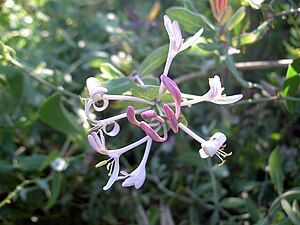Curly honeysuckle
| Curly honeysuckle | ||||||||||||
|---|---|---|---|---|---|---|---|---|---|---|---|---|

Curly honeysuckle ( Lonicera implexa ) |
||||||||||||
| Systematics | ||||||||||||
|
||||||||||||
| Scientific name | ||||||||||||
| Lonicera implexa | ||||||||||||
| Aiton |
The winding honeysuckle or scrub honeysuckle ( Lonicera implexa ) is a right- winding subshrub from the Mediterranean region with strongly fragrant flowers.
description
The honeysuckle is a perennial , evergreen subshrub with bare, blue-green branches and a height of 1 to 3, in exceptional cases up to 7 meters. The leathery leaves are opposite . They are eyed at the bottom, egg-shaped, elliptical and pointed and are 2 to 8 inches long and 2 to 4, rarely only 0.5 inches wide. The top is dark green and shiny, the bottom blue-green, the edges translucent. The upper leaves of flowering branches are fused together at the base. Two to six very fragrant flowers develop in their armpits in a whirling arrangement . The corolla is two-lipped, 2.5 to 4.5 centimeters long, initially yellowish and later reddish. The flower tube becomes 3 to 4 times as long as the hem.
The curling honeysuckle blooms from April to June.
The number of chromosomes is 2n = 36 or 18.
Possible confusion
The conching honeysuckle can be confused with the Tuscan honeysuckle ( Lonicera etrusca ), which has a similar distribution area. The leaves of Lonicera etrusca are hairy on the underside and the species forms long-stalked inflorescences of eight to eleven flowers.
Distribution and location requirements
The curling honeysuckle occurs in the Mediterranean area. The species is found in Morocco, Algeria, Tunisia, Spain, Portugal, Gibraltar, France, the Balearic Islands, Corsica, Sardinia, Sicily, Malta, Italy, Slovenia, Croatia, Montenegro, Bosnia-Herzegovina, Albania, North Macedonia, Greece, in the Aegean Sea and in European and Asian Turkey. It thrives in forests, maquis and hedges, but also as an ornamental plant.
etymology
The generic name Lonicera is derived from the name of the 16th century biologist Adam Lonitzer . The specific epithet implexus is the Latin expression for intertwined or interwoven .
supporting documents
literature
- Ingrid Schönfelder, Peter Schönfelder : The cosmos Mediterranean flora . Franckh, Stuttgart 1999, ISBN 3-440-07803-5
Individual evidence
- ↑ Lonicera implexa entry at GRIN (English, accessed October 8, 2008)
- ↑ a b c d Schönfelder et al .: Die Kosmos-Mediterraneanflora , p. 222
- ↑ Lonicera implexa at Tropicos.org. In: IPCN Chromosome Reports . Missouri Botanical Garden, St. Louis
- ↑ Lonicera etrusca entry at GRIN (eng., Accessed on October 9, 2008)
- ^ E. von Raab-Straube (2017+): Caprifoliaceae. - In: Euro + Med Plantbase - the information resource for Euro-Mediterranean plant diversity. Datasheet Caprifoliaceae
- ↑ Helmut Genaust: Etymological dictionary of botanical plant names. 3rd, completely revised and expanded edition. Nikol, Hamburg 2005, ISBN 3-937872-16-7 , p. 349 (reprint from 1996).
- ↑ Helmut Genaust: Etymological dictionary of botanical plant names. 3rd, completely revised and expanded edition. Nikol, Hamburg 2005, ISBN 3-937872-16-7 , p. 304 (reprint from 1996).

